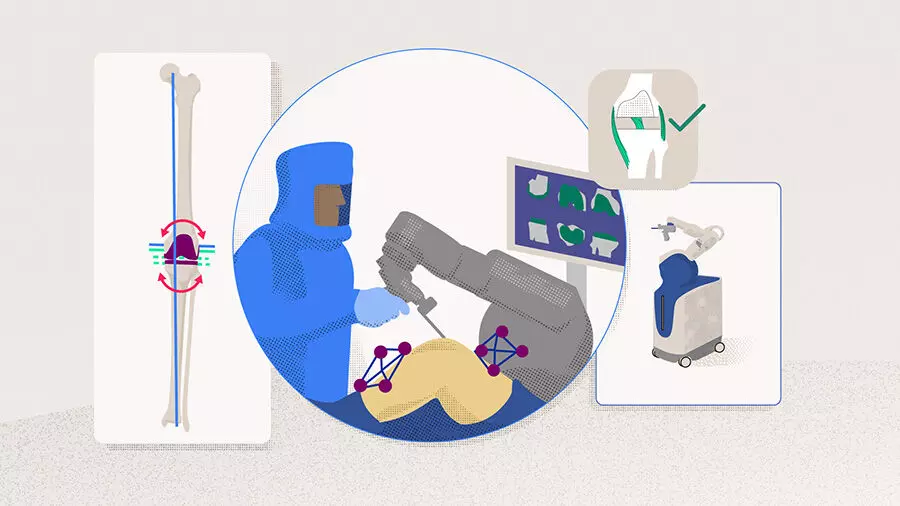RA-TKA offers superior short-term outcomes over conventional techniques, but long-term benefits uncertain: study
- byDoctor News Daily Team
- 16 October, 2025
- 0 Comments
- 0 Mins

Bartlomiej Dobromir Bulzacki‑Bogucki et alconducted a systematic review of the literature to evaluate long-term clinical and radiological outcomes, postoperative complications, and implant survivorship of robotic-assisted total knee arthroplasty (RA-TKA) compared to conventional manual total knee arthroplasty (Co-TKA). A systematic review of the literature was performed with a primary search on Medline through PubMed. The PRISMA 2009 flowchart and checklist were used to edit the review. Exclusively human studies comparing RA-TKA with Co-TKA, with at least 12-month follow-up, were included. Outcomes assessed included clinical and radiographic results, postoperative complications, and implant survivorship. The key findings of the study were: • Twenty-three articles met the inclusion criteria, mostly rated as level II or III evidence. RA-TKA was associated with improved component alignment, better knee balance, reduced blood loss, and soft tissue preservation. • These findings were linked to lower postoperative pain and reduced opioid consumption. • Regarding long-term outcomes, RA-TKA showed similar rates in post-operative complications compared to Co-TKA, though results varied across studies. • Data on implant survivorship were limited, with most studies reporting comparable medium- and long-term survival rates between RA-TKA and Co-TKA. The authors concluded – “RA-TKA and CO-TKA surgical procedures differ in several aspects. RA TKA allows for better soft tissue preservation, improved component alignment, reduced intraoperative blood loss, and improved knee balance. These factors contribute to lower reported postoperative pain and reduced opioid use in the RA TKA group leading to quicker postoperative recovery and a smoother, more satisfactory return to daily life, highlighting the critical role of robotic assistance in TKA procedures, particularly in fast recovery and fast-track protocols, along with personalized and focused postoperative rehabilitation protocols. Further studies in this direction are strongly needed. Additionally, the long-term clinical outcomes and survivability of RA-TKA implants still need to be thoroughly studied, especially in comparison with the outcomes of conventional prostheses.” Further reading: Robotic‑assisted total knee arthroplasty: Promise or parity in long‑term outcomes? Bartlomiej Dobromir Bulzacki‑Bogucki et al MUSCULOSKELETAL SURGERY https://doi.org/10.1007/s12306-025-00922-9
Disclaimer: This website is designed for healthcare professionals and serves solely for informational purposes.
The content provided should not be interpreted as medical advice, diagnosis, treatment recommendations, prescriptions, or endorsements of specific medical practices. It is not a replacement for professional medical consultation or the expertise of a licensed healthcare provider.
Given the ever-evolving nature of medical science, we strive to keep our information accurate and up to date. However, we do not guarantee the completeness or accuracy of the content.
If you come across any inconsistencies, please reach out to us at
admin@doctornewsdaily.com.
We do not support or endorse medical opinions, treatments, or recommendations that contradict the advice of qualified healthcare professionals.
By using this website, you agree to our
Terms of Use,
Privacy Policy, and
Advertisement Policy.
For further details, please review our
Full Disclaimer.
Recent News
Number of steps taken matters more for better heal...
- 22 October, 2025
Immunotherapy after surgery shows potential in pre...
- 22 October, 2025
Study Finds Fatty Acids as Key Driver of Triple-Ne...
- 22 October, 2025
Kiwi fruits May Effectively Relieve Symptoms of Ch...
- 22 October, 2025
Daily Newsletter
Get all the top stories from Blogs to keep track.


0 Comments
Post a comment
No comments yet. Be the first to comment!